Related Content
Content

Share
Our guide to arriving and departing from Paris by train includes both tips and info on how to travel between the stations and the city centre; and also which station you'll need to head to when travelling away from the French capital.
You can click the links contained within the text to access more info about the trains, journeys and stations, as there's already (ahem) more than enough text on this article - but hopefully it's all highly useful.
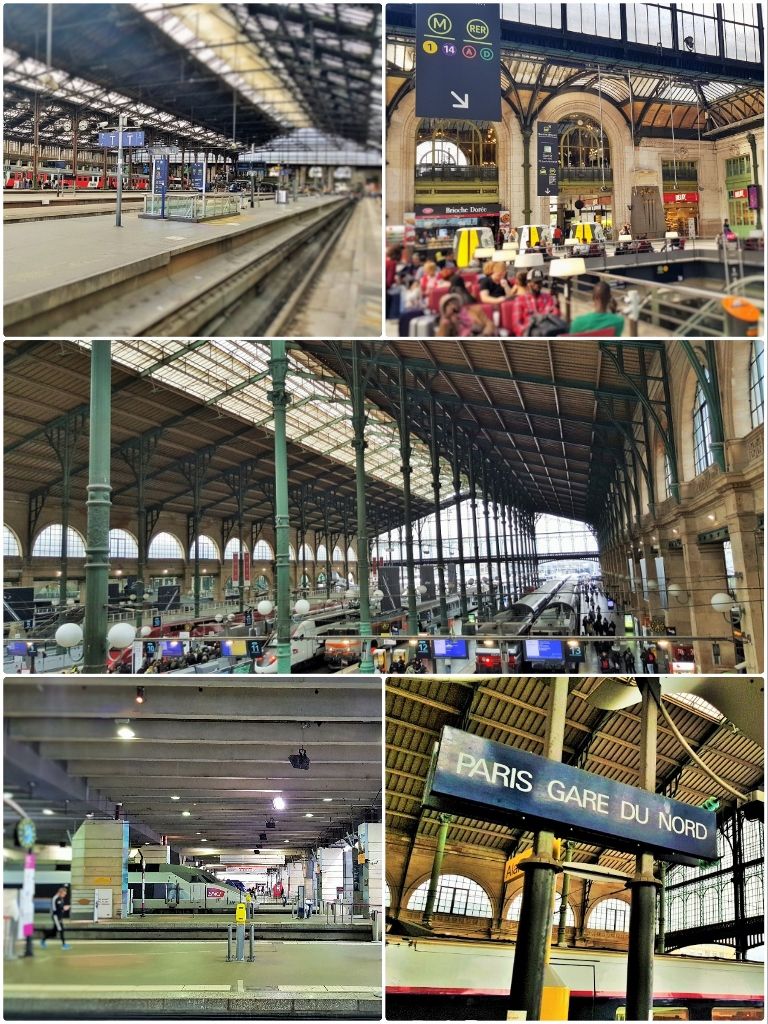
If you would like assistance in planning a train journey to or from Paris, or want to include the French capital on a rail travel itinerary, take a look at the Concierge Service.
The 7 main stations:
In common with London, the French capital was already a large city before the advent of the railways, so Paris city centre is ringed by seven train stations
(1) Austerlitz l (2) Bercy l (3) Est l (4) Lyon
(5) Montparnasse l (6) Nord l (7) St Lazare
All of these seven stations are terminus stations, meaning that long distance trains to and from Paris, don't travel through the city,
So if your end-to-end train journey involves travelling via Paris, you have to make a transfer between these stations.
Accessing these stations:
Specific information for how to navigate each major station in Paris when arriving by train is available on our station guides - click on the names of the seven stations above.
Here are our GENERAL tips for using public transport to travel to and from the main Paris stations - no matter which mainline station in Paris your train will be arriving at and departing from.
Taking the Metro when Arriving in Paris:
These three things are worth keeping in mind if you will be travelling on from a mainline station by using the metro:
(1) Work out your route to your final destination in the city before you arrive at the station in Paris.
Metro maps and other route info can be harder to track down at stations than you might expect.
(2 ) Though if you’re going to be spending time in Paris, it can be worth downloading the RATP app to your phone.
RATP manages the public transport network in central Paris and its app has an English language route planning function.
(3) If you're going to be spending a couple of days in Paris on a multi-city itinerary, it can be a good idea to split your luggage, leaving your large, heavy bags in the left luggage office at the station where your train arrives.
Particularly if where you'll be staying in the city, is some distance away - and you will then subsequently be departing from the same station in Paris.
Travelling light on the Metro is the way to go if it's at all feasible.
Using the Paris Metro:
If you don't consider short flights of stairs to be an obstacle, then taking the Metro can be a fast, efficient and relatively cheap means of travelling to and from the stations in Paris.
Here are eleven things worth knowing if you will be using the Paris Metro to travel from or to a mainline station:
(1) Most Paris Metro stations are closely spaced.
If your final destination in the city is only two or three Metro stops from the station your train will have arrived at, it’s likely that it will take less than 15 mins to walk there.
(2) Think twice about using the metro if you have heavy luggage etc, because steps are the only means of transferring between the trains and street at the overwhelming majority of stations.
This includes the transfers between the station concourse and the Metro at some mainline stations.
Paris doesn't have a particularly deep level metro, so most of the staircases you will have to use are fairly short, but they can be a hassle if you’re carrying bags or managing small children etc.

(3) In particular try and avoid journeys which also have TRANSFERS between Metro lines, if you have heavy luggage etc.
Many interchanges between lines will involve having to negotiate multiple sets of steps.
(4) We have tried to track down a list of the few stations that are equipped with escalators, but it has proved elusive.
Partially because the view of Parisians themselves is that there’d be no point in such a list - because the escalators can’t be 100% relied upon.
Though when they are available at a station they're more likely to be working than not.
(5) Ticket gates that can be opened by staff at are comparatively rare.
Wider gates that are compatible with large items of luggage can also be tricky to track down.
The normal scenario involves pushing your bags through an opening in the gate-line and then leaving it there while you use a nearby ticket gate.
So you won’t have your hands on your bags at all times – take note if you are a wary traveller and will be travelling alone.
(6) The coaches on metro trains are comparatively small and they don’t have luggage racks etc.
Try to keep your bags away from the doors and putting bags on seats will be frowned on by Parisians; and won’t even be an option at busy times.
Also guaranteed to incur the wrath of Parisians, is sitting on the fold down seats by the doors when the trains are busy.
(7) If it’s feasible, avoid using the metro in rush hours, between 07:45 – 09:45 and between 16:00 and 18:30.
Allow more time if have to travel at these times, you may not be able to board the first or second train to arrive.
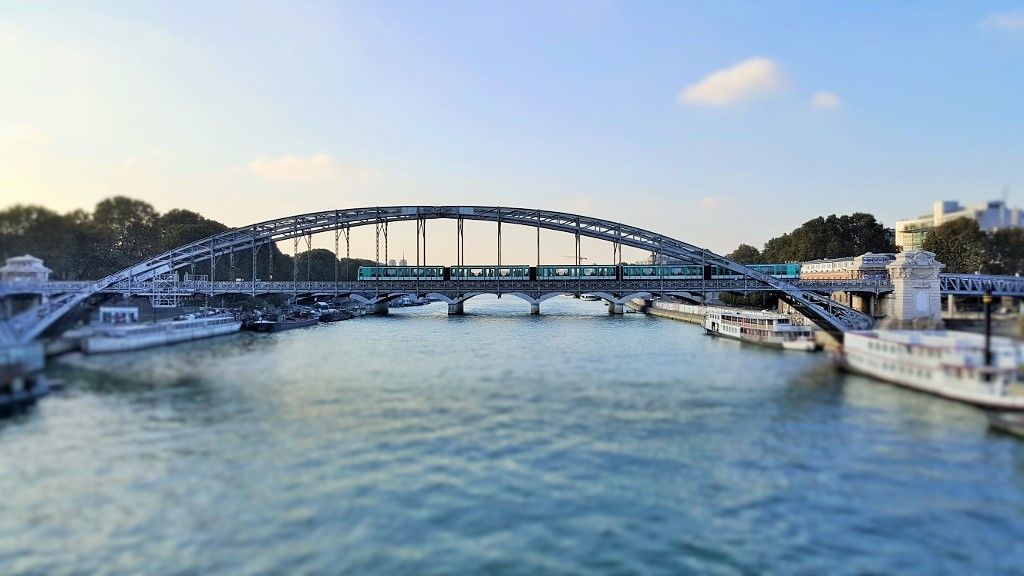
(8) In contrast to the older Métro lines, the newer Line 14 has escalators and/or elevators which provide the access between the train and street level and its stations.
So if you will be arriving or departing from the Gare De Lyon, Bercy or St-Lazare, check if taking Line 14 is an option
It’s particularly useful if you will be heading to and from the areas in the city around Pyramides or Madeleine stations.
(9) The destinations of the trains is important, as the signage on the metro uses these stations at the end of the lines, and not north/south etc, to indicate direction.
(10) Some of the Metro stations at the mainline stations can be exceptionally large, so the platforms/tracks that some Metro lines use, can be quite a distance from the entrance to the Metro part of the station.
Meaning that the access from and to the long distance trains, can be comparatively far away from the parts of the station that the Metro lines arrive at and depart from, which leads to long transfers.
Particularly worth knowing is that:
- At Saint-Lazare line 12 is further from the main station than the other lines.
- At the Gare De Lyon the quickest access to and from Metro Line 1 is different to the shortest route to and from line 14.
- At Montparnasse station lines 4 and 12 are much further from the mainline station metro entrance than lines 6 and 13.

(11) You won't usually need to use your ticket to open the ticket gates in order to exit from the platforms, but keep your ticket on you until you have left the station.
An alternative to Metro tickets:
The excellent parisbytrain website has all the info you will need about metro tickets.
In particular, what's worth knowing is that the Paris Visite Passes can be a good alternative to Metro tickets
If you will be planning on making some other journeys by Metro on the day of your arrival, then buy one of these passes in the Metro at the station when you first arrive in Paris.
You can then use it to travel from the station to your final destination in the city and then on any subsequent trains you take, within the Paris area, later the same day.
Using the RER:

The RER in Paris is a system of main line trains which also cross the city centre in tunnels, so in central Paris these trains are below ground like the Metro.
In the city centre think of them as express Metro lines, as the same central Paris tickets/passes can be used on both the Metro and RER trains.
They can be a better option than taking the metro - they’re faster and are bigger trains, so travelling with luggage etc on them is less of a hassle.
Another big plus is that most city centre RER stations are connected to street level by escalators and/or elevators – though it's best to avoid having to 100% rely on them to give access to and from the trains.
Six other things also worth knowing about the RER:
(1) The only mainline stations in Paris directly connected to the RER are Austerlitz, the Gare De Lyon, the Gare Du Nord and St-Lazare.
(2) If your train will be arriving at or departing from the Gare De Lyon, the RER Line A is a better option than the Metro for reaching many areas of central Paris.
Particularly if your final destination or starting point is near Auber or Charles-De-Gaulle-Étoile stations.
(3) If you will be connecting between the Gare Du Nord and the Left Bank area of the city on the south bank of The Seine, then taking RER line B is a better option than taking the Metro.
Line B stops at St Michel-Notre Dame where connections are also available to RER line C, which stops at the Musée D’Orsay and by the Eiffel Tower.
(4) RER Line C provides the quickest access between Austerlitz stations and locations in central Paris on the south bank of the River Seine.
(5) RER Line D provides the best public transport connection from the Gare Du Nord to the Gare De Lyon and from the Gare De Lyon to the Gare Du Nord.

(6) Taking RER Line E is the easiest means of transferring between the Gare Du Nord and St Lazare.
Using the buses:
When arriving in Paris by train, taking the bus can often be a better option than taking the Metro on to your final destination in the city centre.
- They’re easier to manage if you have luggage, or will be travelling with small children.
- Tickets can be purchased on board.
- They can take you to areas of the city, which aren’t served by direct Metro lines from the station.
The RATP app can be a big help with showing you at which stops you'll need to board and leave the bus.
Though some bus stops are given the names of stations, despite the fact that they can be a couple of blocks away from them.
The plus points of taking the bus are inevitably negated if the stop is a 5 - 8 min walk from the station and in a location, which isn't particularly obvious - so ShowMeTheJourney has deliberately excluded those stops and routes from those suggested below.
Route/line 91
The bus routes in Paris have just been reorganised and the newly updated Paris bus map is here - though the number of bus routes between the stations and the heart of Paris has been reduced.
Of particular note to rail travellers is that Line/route 91 is now the core inter-station bus service in central Paris.
One end of its route commences at the Gare Du Nord and the other commences at Montparnasse station and in between them it calls at the Gare de l'Est, the Gare De Lyon and Austerlitz.
When heading to the Gare Montparnasse leave the bus at this stop marked 'Gare Montparnasse' - which is two stops before the terminus.
The particularly useful routes for cross Paris rail connections are:
From Austerlitz:
Line 63 to Gare De Lyon from the 'Cour Seine' stop
Line 91 to Montparnasse, from this stop on Boulevard de L'Hopital)
Line 91 to the Gare De Lyon, the Gare de l'Est and the Gare Du Nord from this stop on Boulevard de L'Hopital.
From Paris Est:
Line 32 to St Lazare from one of the stops on the Boulevard de Strasbourg, the square in front of the station (there is no direct Metro line between these two stations)
Line 91 to Montparnasse via the Gare De Lyon and Austerlitz, from a stop on Rue du 8 Mai 1945.
From Paris Lyon:
Line 72 to the Louvre and the Palais Royal from this stop on Rue De Bercy - a good alternative to Metro line 1
Line 91 to the Gare De l'Est and the Gare Du Nord from the stop on Boulevard Diderot
Line 91 to Austerlitz and Montparnasse from a different stop on on Boulevard Diderot
From Paris Montparnasse:
Line 91 to Austerlitz, Gare De Lyon, the Gare De Lyon and the Gare Du Nord -
From this stop accessible via Hall 2 - which exits on to the Place de Cinq Martyrs du Lycée Buffon
And from this stop in the small bus station on Boulevard de Vaugirard, over to the left of the main street level exit at the front of the station.
Line 94 to St Lazare from this stop in the small bus station on Boulevard de Vaugirard, over to the left of the main street level exit at the front of the station.
Line 95 to St Lazare from the same stop in the small bus station on Boulevard de Vaugirard, over to the left of the main street level exit at the front of the station.
From Paris Nord:
Line 26 and Line 43 to St Lazare from the stop on Rue de Dunkerque, directly outside the station
Line 38 to the Pompidou Centre and Notre Dame from this stop on Rue Du Fauborg Saint-Martin - an alternative to RER Line B
Line 39 to the Palais Royale and Montparnasse from the stop on Rue de Saint-Quentin
Line 45 to Place De La Concorde from the stop on Rue de Dunkerque, directly outside the station
Line 91 to Montparnasse via the Gare De Lyon and Austerlitz from the stop on Rue de Saint-Quentin
From St Lazare:
Line 26 to the Gare Du Nord from the stop on the Cour De Rome, the square outside the frontage of the station, on its right hand side when facing away from the trains
Line 29 to the Gare De Lyon from the stop on Rue St Lazare
Line 32 to the Gare de l’Est from the stop on Rue St Lazare (there is no direct Metro line between these two stations)
Line 94 to Montparnasse from the stop on Rue St Lazare
Departing from Paris:
Much of the info above re: using public transport in Paris also applies if you will be heading to a mainline station to take a train from the city.
But there are two other things in particular to look out for, if you use the Metro or RER to arrive at the station your train will be leaving from.
(1) If you will be connecting into a long distance train, follow the signs within the Metro/RER marked ‘Grande Lignes’.

(2) Also check that you’re looking at the electronic departure screens marked ‘Grande Lignes’ - other electronic screens will only show the regional or RER trains.
Click the destination links below for access to guides on how to make these train journeys from Paris.
from Austerlitz
Trains from Paris Austerlitz
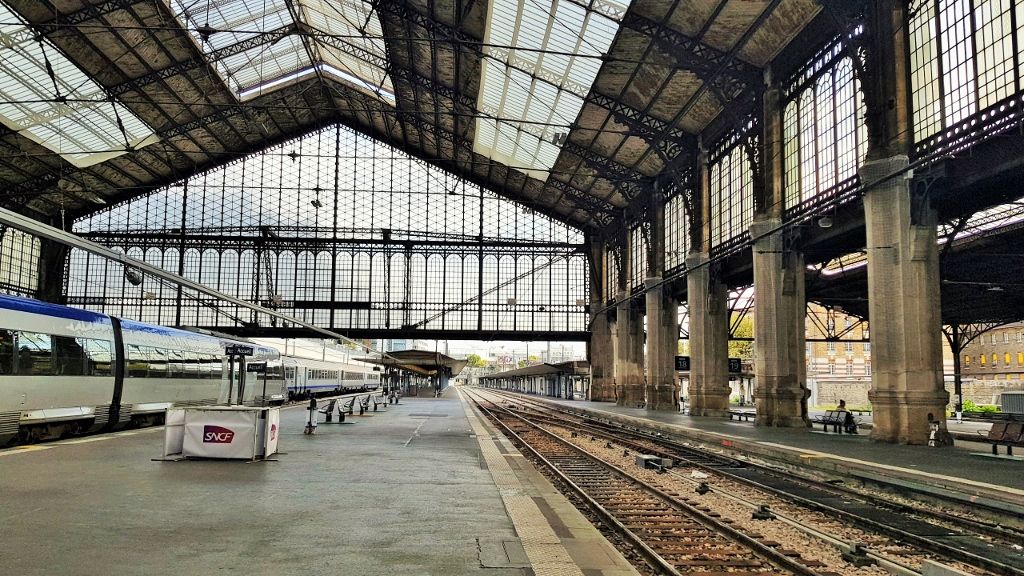
Trains from this station go to:
Toulouse (by IC trains) l Tours (by IC trains)
Faster TGV trains to Toulouse and Tours depart from Paris Montparnasse - see below.
from Bercy
Trains from Paris Bercy Bourgogne - Pays d'Auvergne (Paris Bercy)

Trains from this station go to:
Dijon (by TER trains) l Clermont-Ferrand
Lyon (by TER trains) l Nevers l Vichy
Faster TGV trains to Dijon and Lyon depart from the Gare De Lyon - see below.
from Est
Trains from Paris Gare de l’Est (Paris Est)
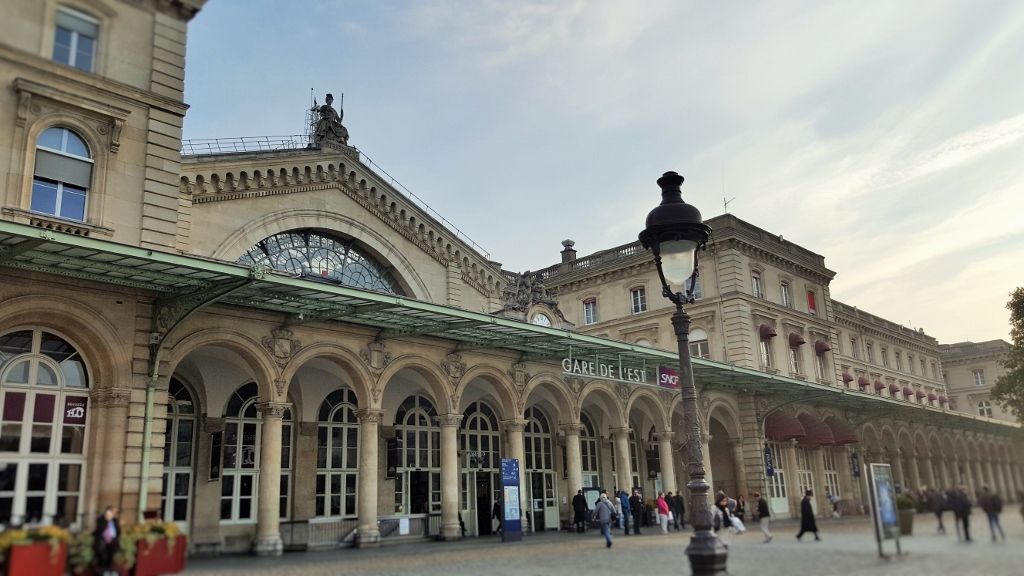
Trains from this station go to:
Belfort l Colmar l Frankfurt l Luxembourg
Metz l Munchen l Mulhouse (by IC trains)
Nancy l Reims l Strasbourg
Stuttgart l Troyes
from Lyon
Trains from Paris Gare De Lyon (Paris Lyon)

Trains from this station go to:
Aix-en-Provence l Aix-les-Bains l Annecy
Basel/Bale l Bern l Besancon l Béziers
Cannes l Chambery l Dijon (by TGV train)
Lyon (by TGV train) l Marseille l Menton
Milano l Monte-Carlo l Montpellier
Mulhouse (by TGV train) Narbonne l Nice
Nimes l Padova/Padua l Perpignan
St Etienne l Torino/Turin l Toulon
Valence l Venezia/Venice
from Montparnasse
Trains from Paris Montparnasse
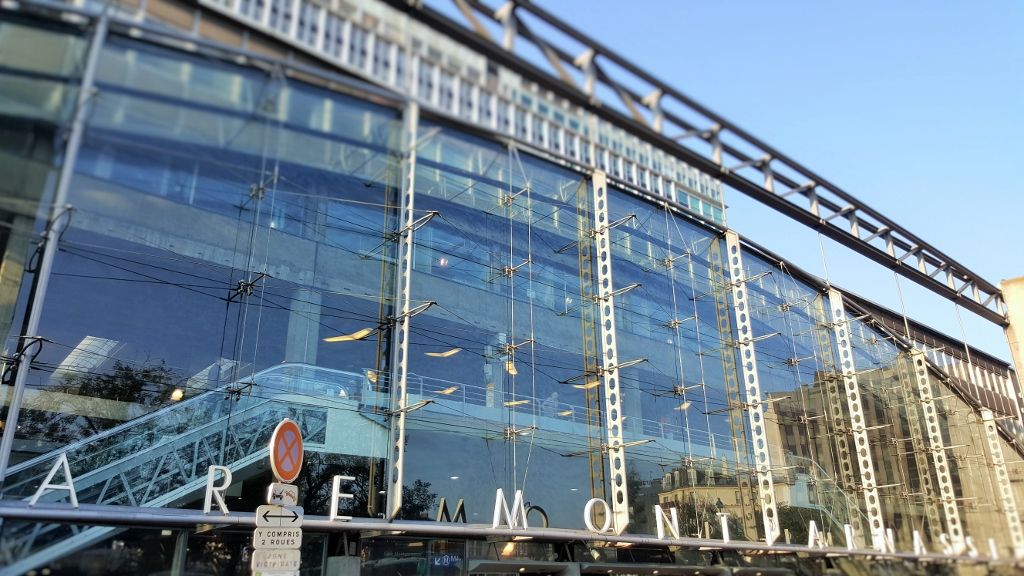
Trains from this station go to:
Angers l Angouleme l Bayonne l Biarritz
Bordeaux l Brest l Chartres l Futurescope
Hendaye l La Rochelle l Le Mans
Lorient l La Rochelle l Lourdes l Morlaix
Nantes l Poitiers l Quimper l Rennes
St Malo l Tarbes l Toulouse (by TGV train)
Tours (by TGV train)
from Nord
Trains from Paris Gare du Nord (Paris Nord)
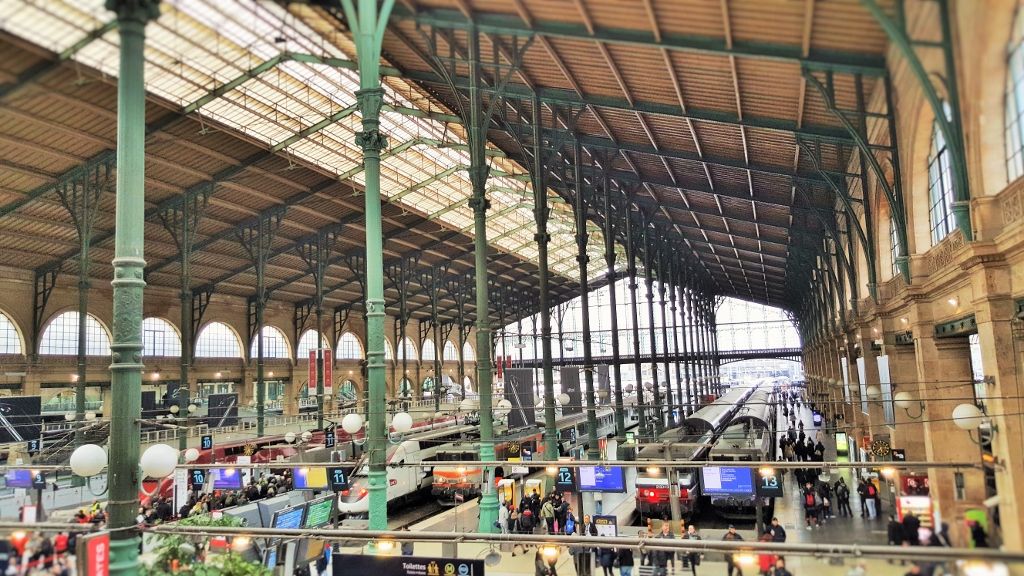
Trains from this station go to:
Amiens l Amsterdam l Antwerp/Anvers
Beauvais l Boulogne l Bruxelles/Brussels
Dortmund l Koln/Cologne l [Lill
from St Lazare
Trains from Paris Saint Lazare

Trains from this station go to:
Deauville l Le Havre l [Rouen](/train-travel-info/journeys/from-paris-to-rouen-by-train/
Avoiding the transfer between the main stations:
Having to transfer between stations in Paris, when making an end-to-end journey by train, is a scenario that’s best avoided.
However, what visitors to France can be unaware of, is that it’s often possible to avoid central Paris when travelling in France by train.
From Lille you can take direct TGV trains to:
Aix-en-Provence; Angers; Angouleme; Avignon; Bordeaux; Dijon; Lyon; Marseille; Montpellier; Mulhouse, Nantes; Nimes; Poitiers; Rennes; St Pierre des Corps (Tours); Strasbourg and Valence
The direct train from Lille to Nice via Cannes and Antibes only departs on Fridays.
From Lyon you can take direct TGV trains to:
Bruxelles; Le Havre; Lille; London; Nantes; Rennes and Rouen.
From Nantes and Rennes you can direct TGV trains to Lille, Lyon and Strasbourg
When you have to make the transfer
However, when making a transfer between stations in Paris can’t be avoided, you can find the details of how to take these journeys by Metro and RER these station guides.
Est l Lyon l Montparnasse
Simply click on the name of the station and then scroll down the page you will be taken to
14 day trips from Paris:
Paris also makes for a great base for exploring northern France by Train.
We’ve ranked these day trip ideas by journey time from the station in Paris, in which you’ll be commencing your journey.
Click the name of the destination for access to online guides to each location
When they're available, click the Read More buttons to access a guide to making this train journey.
Book tickets online in advance to save money on the journeys we have marked with (*).
Though to save money, you will have to select specific trains for you outward and return journeys.
For journeys which don't have that symbol, you can buy tickets last minute at the station, without any financial penalty or journey constraints – and take any train back to Paris.
to Fontainbleu
To Fontainbleu; 43 mins from the Gare De Lyon.
You will be taking a local* or TER train to Fontainebleau-Avon station, where a shuttle bus to the chateaux will meet the trains
Visite Paris cards are valid on these trains and they can also be used on the bus, but if you don’t have a card, the bus ticket will cost €2.
Between 09:00 and 13:00 trains to Fontainebleau-Avon depart from Hall 1 in the Gare De Lyon every 30 mins.
The final destination of the train will usually be Montargis, Monterau or Laroche-Migennes.
*For some reason the train numbers for these local trains to Fontainebleau-Avon begin with ‘RER’, but these are not typical RER trains.
They don’t cross Paris, and you won’t find Fontainebleau-Avon station on the RER route map and at the Gare De Lyon they don’t depart from the part of the station, which the other RER trains use.
to Reims*
Reims in 45 mins from the Gare de l’Est.
to Versailles
Versailles in 45-50 mins from St Michel-Notre Dame station
To visit the palace you need to take a train on RER Line C route C5 to Versailles-Château-Rive-Gauche station, which is a terminus station.
So on the departure screens check that the train will be heading to this specific station.
Versailles-Château-Rive-Gauche station is a 13 min walk from the entrance to the Versailles Palace complex.
These trains on line RER C also makes stops at these stations in central Paris – Invalides; Musée D’Orsay and Champs de Mars-Tour Eiffel.
They also call at Paris Austerlitz main line station.
Trains to Versailles-Château-Rive-Gauche depart every 15 or 20 mins, but take care that you don’t board a train to Versailles-Chantiers – that station is in Versailles town centre.
Visite Paris cards are valid on these trains.
to Disneyland Paris
Disneyland Paris in 48 mins from Chatelet Les-Halles station
You need to take a train on RER Line A route A4 to Marne-la-Vallée Chessy station, which is located across the street from the entrance to the park.
These trains on RER Line A route A4 also make stops at these other stations in central Paris; Charles-de-Gaulle Étoile and Auber.
They also call at Paris Lyon.
Trains to Marne-la-Vallée Chessy station depart at least every 12 mins, though take care NOT to board trains heading for Boissy-Saint-Leger.
Visite Paris cards are valid on these trains.
to Orléans
Orléans in around 1hr from Austerlitz station.
to Giverny*
Giverny in around 1hr 15 mins from St-Lazare station
A day trip to Giverny needs to be planned with care, as the connections from Paris aren’t particularly frequent.
The first stage of the journey is to take a train to ‘Vernon-Giverny’ station, but there can be gaps of more than two hours between departures .
So it’s worth looking up this journey online - even if you don’t want to book tickets in advance.
Though you will only save around a euro if you do also book your train tickets in advance online.
At St-Lazare you'll be looking for the train that will be likely terminating at Rouen, then on arrival at Vernon-Giverny, you will need to take the bus that is scheduled to meet the trains.
*The journey time includes the train journey and the bus transfer.
Your train ticket won’t include the bus ride and you can buy tickets from the driver, the return trip from and to the station will cost around €6.50.
to Chartres
Chartres in around 1hr – 1hr 15mins mins from the Gare Montaparnasse.
to Aminens*
Amiens in around 1hr – 1hr 15mins mins from the Gare Du Nord.
to Lille*
Lille in around 1hr 10mins mins from Paris Gare Du Nord.
How to travel by train from Paris to Lille
to Rouen*
Rouen in around 1hr 10mins – 1hr 25 mins from Paris St-Lazare.
There are fewer fast trains between Paris and Rouen on Sundays.
to Tours*
Tours in 1hr 12 min – 1hr 30 mins from Paris Montparnasse.
to Beauvais
Beauvais in around 1hr 15mins from the Gare Du Nord.
to Futurescope*
Futurescope in around 1hr 50mins from Paris Montparnasse.
to Mont St Michel*
Mont St Michel in around 3hr – 3hr 15 mins* from Paris Montparnasse.
*The journey time includes the bus transfer from Rennes station to Mont St Michel.
There are two different routes if you want to travel by train + bus from Paris to Mont St Michel (1) via Dole and (2) the route we have singled out via Rennes.
We suggest travelling via Rennes because:
- it’s usually cheaper, particularly when booking in advance;
- the connections are more frequent;
- the end-to-end journey will be around 15 mins faster.
For the inside track on how to take many of these day trip suggestions, we highly recommend taking a look at this great guide on Savvy Backpacker.

Simon Harper
I wanted to share my passion for train travel and explain how anyone can take the fantastic journeys I have taken.

This is one of more than 100 train travel guides available on ShowMeTheJourney, which will make it easier to take the train journeys you want or need to make. As always, all images were captured on trips taken by ShowMeTheJourney.

